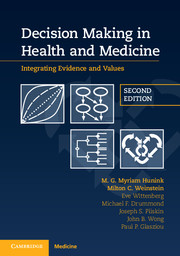Book contents
- Frontmatter
- Dedication
- Contents
- Foreword
- Foreword to the first edition (2001)
- Preface
- Acknowledgments
- list of Abbreviations
- About the authors
- 1 Elements of decision making in health care
- 2 Managing uncertainty
- 3 Choosing the best treatment
- 4 Valuing outcomes
- 5 Interpreting diagnostic information
- 6 Deciding when to test
- 7 Multiple test results
- 8 Finding and summarizing the evidence
- 9 Constrained resources
- 10 Recurring events
- 11 Estimation, calibration, and validation
- 12 Heterogeneity and uncertainty
- 13 Psychology of judgment and choice
- Index
- References
3 - Choosing the best treatment
Published online by Cambridge University Press: 05 October 2014
- Frontmatter
- Dedication
- Contents
- Foreword
- Foreword to the first edition (2001)
- Preface
- Acknowledgments
- list of Abbreviations
- About the authors
- 1 Elements of decision making in health care
- 2 Managing uncertainty
- 3 Choosing the best treatment
- 4 Valuing outcomes
- 5 Interpreting diagnostic information
- 6 Deciding when to test
- 7 Multiple test results
- 8 Finding and summarizing the evidence
- 9 Constrained resources
- 10 Recurring events
- 11 Estimation, calibration, and validation
- 12 Heterogeneity and uncertainty
- 13 Psychology of judgment and choice
- Index
- References
Summary
Firstly, do no (net) harm.
(adapted from) HippocratesIntroduction
Some treatment decisions are straightforward. For example, what should be done for an elderly patient with a fractured hip? Inserting a metal pin has dramatically altered the management: instead of lying in bed for weeks or months waiting for the fracture to heal while blood clots and pneumonia threatened, the patient is now ambulatory within days. The risks of morbidity and mortality are both greatly reduced. However, many treatment decisions are complex. They involve uncertainties and trade-offs that need to be carefully weighed before choosing. Tragic outcomes may occur no matter which choice is made, and the best that can be done is to minimize the overall risks. Such decisions can be difficult and uncomfortable to make. For example, consider the following historical dilemma.
Benjamin Franklin and smallpox
Benjamin Franklin argued implicitly in favor of the application to individual patients of probabilities based on previous experience with similar groups of patients. Before Edward Jenner’s discovery in 1796 of cowpox vaccination for smallpox, it was known that immunity from smallpox could be achieved by a live smallpox inoculation, but the procedure entailed a risk of death. When a smallpox epidemic broke out in Boston in 1721, the physician Zabdiel Boylston consented, at the urging of the clergyman Cotton Mather, to inoculate several hundred citizens. Mather and Boylston reported their results (1):
Out of about ten thousand Bostonians, five thousand seven hundred fifty-nine took smallpox the natural way. Of these, eight hundred eighty-five died, or one in seven. Two hundred eighty-six took smallpox by inoculation. Of these, six died, or one in forty-seven.
- Type
- Chapter
- Information
- Decision Making in Health and MedicineIntegrating Evidence and Values, pp. 53 - 77Publisher: Cambridge University PressPrint publication year: 2014
References
- 2
- Cited by



